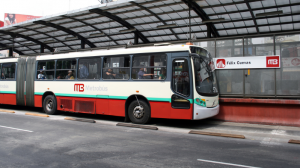By Alexa Singer
Over the past several decades, climate change has become a global issue that has demanded the attention of major nations through media, natural disasters, and academic discussions on scientific evidence. With this phenomena approaching nearer and nearer, planners, government officials, consultants, etc. have begin to encourage citizens to begin adapting alternative ways of living into their daily routine.

Los Angeles Smog
Corwin, Jim. “Los Angeles Air Pollution.” 30 December 2009. Online Image. Flikr. 20 November 2013.
These human impacts on the environment are contributing to the exponential effect of climate change. Greenhouse gases are arguably the most influential factor, which has led to climate change’s increased threatening force. However, this trend has the potential to be halted and even potentially reversed. Sustainable transportation is an investment that has the ability to transform unhealthy, smog-covered, congested cities into habitable, economically viable urban metropolises prepared to overcome climate change. Currently, too many streets are defined by standstill traffic, emitting exhausts into the environment. Throughout the past few decades, an international culture has formed with a reliance on and infatuation with private automobile, which are comprised of inefficient fuels, time wasted in traffic, unnecessary deaths (Kyte). The black carbon produced by the pollution and fumes is contributing to the steepened climate change and creating an unhealthy planet.

A Mega-Metrobus in TIacoquemeca, Mexico City
R. Luis. “Metrobus.” 3 April 2007. Online Image. Luis R.’s Photostream. 21 November 2013.
However, the world has the opportunity to reverse this trend through building sustainable infrastructure: specifically, public transit alternatives. Hong Kong, Mexico City and Guangzhou are all examples of the positive results. Hong Kong decreased the heavy congestion by taxing personal vehicles and building more mass transit options; Mexico City implemented stricter fuel regulations and developed a extremely successful Metrobus transit network, which is now the inhabitant’s main form of transportation; Guangzhou developed a greenway bus rapid transportation system and a bike-sharing system to cut down 86,000 tons of carbon dioxide per year (Kyte).
So, it is established that climate change, greenhouse gases, and current transportation trends are a major problem within cities across the globe. The question is how can planning solve these issues?
The key issues in sustainable transportation that planners must address are creating access (not mobility), moving people (not cars), reclaiming city space for walking and pedaled vehicles, and subsidizing private motor vehicles (Rastogi, 1321).
Often, the argument against sustainable public transport deals with the large investment in the infrastructure. However, the costs have to be examined from a long-term perspective, including the environmental costs. Additionally, the expenses of freeways, highways, bridges, parking spots, and other accessories of the automobile are not always accounted in the costs; therefore, many calculations of the cost of the automobile are inaccurate. Realistically, the ratio of freeway to highway to bus lane to high quality cycle routes is 20 : 10 : 5 : 1 (Rastogi, 1341). Therefore, this standard equation proves that although implementing a bike-sharing system seems to be expensive, money can ultimately saved through eliminating costs of maintain freeways and avoiding fuel expenses of automobiles.

Montreal Bike Share System.
Chan, Kenneth. “Reusable Bike Share Helmets.” Vancity Buzz. N.p., n.d. Web. 2 Dec. 2013.
As exemplified above, there are many alternatives to the private automobile, including bicycles, public buses, subways, railway systems, and of course, simply walking. It is not possible to declare one method of transit the best or most successful because it truly depends on the size, location, and other specific features of the city. However, private automobiles are certainly not the best option for any city in this day and age. In sum, it is imperative that city planners and elected officials gain support for sustainable transportation and begin the implementation immediately. Climate change has already arrived, and it is now not a question of saving the planet for future generations: now, the international community must adapt to save THEIR own planet. There is no longer a choice. Citizens must adapt. The first step is through sustainable transportation.
Works Cited
Davoudi, Simin, Jenny Crawford, and Abid Mehmood. Planning for Climate Change. London: Earthscan, 2009. Print.
Kyte, Rachel. “One Investment That Can Make Unhealthy Cities Livable and Fight Climate Change: Sustainable Transportation.” Development in a Changing Climate: Making Our Future Sustainable. The World Bank Group, 17 Nov. 2013. Web. 21 Nov. 2013.
Rastogi, Rajat. “Promotion of Non-Motorized Modes as a Sustainable Transportation Option: Policy and Planning Issues.” Current Science 100.9 (2011): 1340-348. Print.
